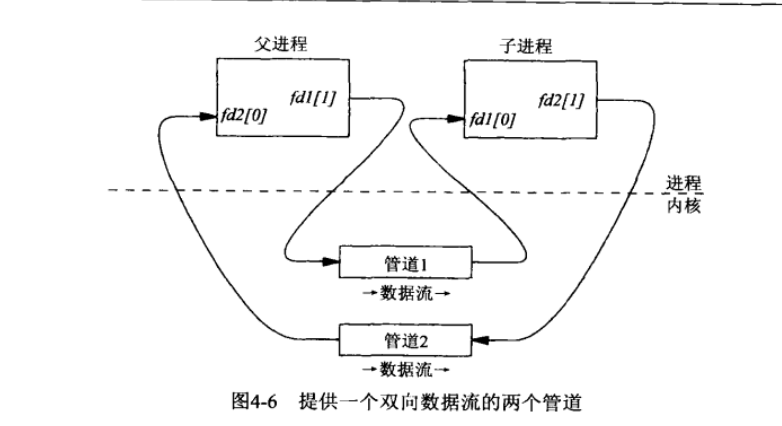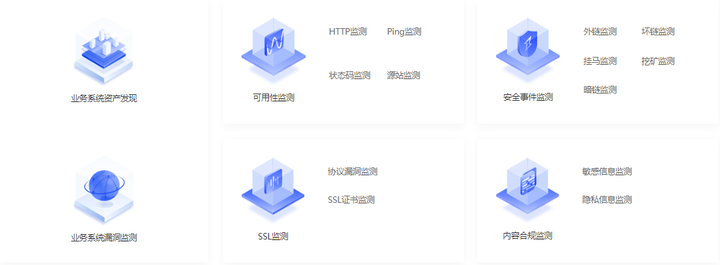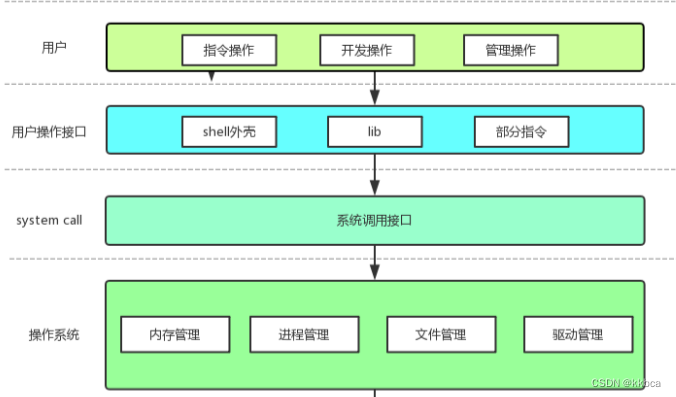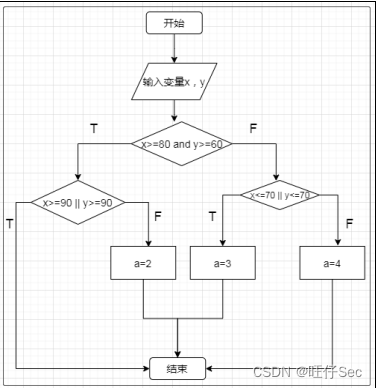一、题目
给你一个链表数组,每个链表都已经按升序排列。请你将所有链表合并到一个升序链表中,返回合并后的链表。
示例 1:
输入:lists = [[1,4,5],[1,3,4],[2,6]]
输出:[1,1,2,3,4,4,5,6]
解释:链表数组如下:[ 1->4->5, 1->3->4, 2->6 ]
将它们合并到一个有序链表中得到1->1->2->3->4->4->5->6
示例 2:
输入:lists = []
输出:[]
示例 3:
输入:lists = [[]]
输出:[]
k == lists.length
0 <= k <= 10^4
0 <= lists[i].length <= 500
-10^4 <= lists[i][j] <= 10^4
lists[i]按 升序 排列
lists[i].length的总和不超过10^4
二、代码
合并两个有序链表: 在解决「合并K个排序链表」这个问题之前,我们先来看一个更简单的问题:如何合并两个有序链表?假设链表a和b的长度都是n,如何在O(n)的时间代价以及O(1)的空间代价完成合并? 这个问题在面试中常常出现,为了达到空间代价是O(1),我们的宗旨是「原地调整链表元素的next指针完成合并」。以下是合并的步骤和注意事项,对这个问题比较熟悉的读者可以跳过这一部分。此部分建议结合代码阅读。
【1】首先我们需要一个变量head来保存合并之后链表的头部,你可以把head设置为一个虚拟的头(也就是head的val属性不保存任何值),这是为了方便代码的书写,在整个链表合并完之后,返回它的下一位置即可。
【2】我们需要一个指针tail来记录下一个插入位置的前一个位置,以及两个指针aPtr和bPtr来记录a和b未合并部分的第一位。注意这里的描述,tail不是下一个插入的位置,aPtr和bPtr所指向的元素处于「待合并」的状态,也就是说它们还没有合并入最终的链表。 当然你也可以给他们赋予其他的定义,但是定义不同实现就会不同。
【3】当aPtr和bPtr都不为空的时候,取val属性较小的合并;如果aPtr为空,则把整个bPtr以及后面的元素全部合并;bPtr为空时同理。
【4】在合并的时候,应该先调整tail的next属性,再后移tail和*Ptr或者bPtr。那么这里tail和*Ptr是否存在先后顺序呢?它们谁先动谁后动都是一样的,不会改变任何元素的next指针。
public ListNode mergeTwoLists(ListNode a, ListNode b) {if (a == null || b == null) {return a != null ? a : b;}ListNode head = new ListNode(0);ListNode tail = head, aPtr = a, bPtr = b;while (aPtr != null && bPtr != null) {if (aPtr.val < bPtr.val) {tail.next = aPtr;aPtr = aPtr.next;} else {tail.next = bPtr;bPtr = bPtr.next;}tail = tail.next;}tail.next = (aPtr != null ? aPtr : bPtr);return head.next;
}
时间复杂度: O(n)。
空间复杂度: O(1)。
【1】顺序合并: 我们可以想到一种最朴素的方法:用一个变量ans来维护以及合并的链表,第i次循环把第i个链表和ans合并,答案保存到ans中。
class Solution {public ListNode mergeKLists(ListNode[] lists) {ListNode ans = null;for (int i = 0; i < lists.length; ++i) {ans = mergeTwoLists(ans, lists[i]);}return ans;}public ListNode mergeTwoLists(ListNode a, ListNode b) {if (a == null || b == null) {return a != null ? a : b;}ListNode head = new ListNode(0);ListNode tail = head, aPtr = a, bPtr = b;while (aPtr != null && bPtr != null) {if (aPtr.val < bPtr.val) {tail.next = aPtr;aPtr = aPtr.next;} else {tail.next = bPtr;bPtr = bPtr.next;}tail = tail.next;}tail.next = (aPtr != null ? aPtr : bPtr);return head.next;}
}
时间复杂度: 假设每个链表的最长长度是n。在第一次合并后,ans的长度为n;第二次合并后,ans的长度为2×n,第i次合并后,ans的长度为i×n。第i次合并的时间代价是O(n+(i−1)×n)=O(i×n),那么总的时间代价为O(∑i=1k(i×n))=O(((1+k)⋅k)/2×n)=O(k^2n),故渐进时间复杂度为O(k^2 n)。
空间复杂度: 没有用到与k和n规模相关的辅助空间,故渐进空间复杂度为O(1)。
【2】分治合并: 考虑优化方法一,用分治的方法进行合并。
1、将k个链表配对并将同一对中的链表合并;
2、第一轮合并以后,k个链表被合并成了k/2个链表,平均长度为2n/k,然后是k/4个链表,k/8个链表等等;
3、重复这一过程,直到我们得到了最终的有序链表。
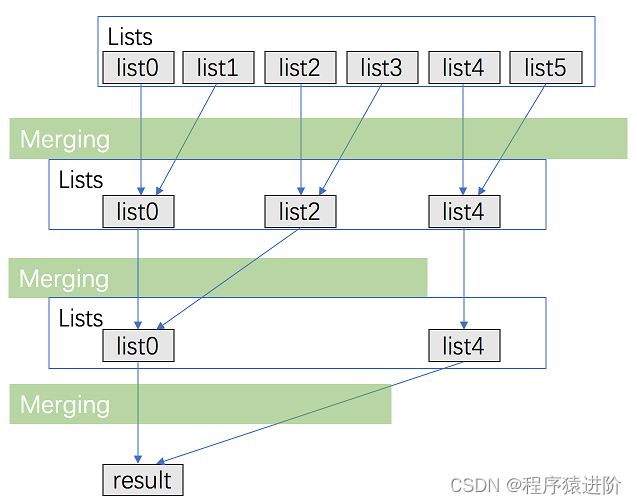
class Solution {public ListNode mergeKLists(ListNode[] lists) {return merge(lists, 0, lists.length - 1);}public ListNode merge(ListNode[] lists, int l, int r) {if (l == r) {return lists[l];}if (l > r) {return null;}int mid = (l + r) >> 1;return mergeTwoLists(merge(lists, l, mid), merge(lists, mid + 1, r));}public ListNode mergeTwoLists(ListNode a, ListNode b) {if (a == null || b == null) {return a != null ? a : b;}ListNode head = new ListNode(0);ListNode tail = head, aPtr = a, bPtr = b;while (aPtr != null && bPtr != null) {if (aPtr.val < bPtr.val) {tail.next = aPtr;aPtr = aPtr.next;} else {tail.next = bPtr;bPtr = bPtr.next;}tail = tail.next;}tail.next = (aPtr != null ? aPtr : bPtr);return head.next;}
}
时间复杂度: 考虑递归「向上回升」的过程——第一轮合并k/2组链表,每一组的时间代价是O(2n);第二轮合并k/4组链表,每一组的时间代价是O(4n)…所以总的时间代价是O(∑i=1∞k/2^i×2^in)=O(kn×logk),故渐进时间复杂度为O(kn×logk)。
空间复杂度: 递归会使用到O(logk)空间代价的栈空间。
【3】使用优先队列合并: 这个方法和前两种方法的思路有所不同,我们需要维护当前每个链表没有被合并的元素的最前面一个,k个链表就最多有k个满足这样条件的元素,每次在这些元素里面选取val属性最小的元素合并到答案中。在选取最小元素的时候,我们可以用优先队列来优化这个过程。
class Solution {class Status implements Comparable<Status> {int val;ListNode ptr;Status(int val, ListNode ptr) {this.val = val;this.ptr = ptr;}public int compareTo(Status status2) {return this.val - status2.val;}}PriorityQueue<Status> queue = new PriorityQueue<Status>();public ListNode mergeKLists(ListNode[] lists) {for (ListNode node: lists) {if (node != null) {queue.offer(new Status(node.val, node));}}ListNode head = new ListNode(0);ListNode tail = head;while (!queue.isEmpty()) {Status f = queue.poll();tail.next = f.ptr;tail = tail.next;if (f.ptr.next != null) {queue.offer(new Status(f.ptr.next.val, f.ptr.next));}}return head.next;}
}
时间复杂度: 考虑优先队列中的元素不超过k个,那么插入和删除的时间代价为O(logk),这里最多有kn个点,对于每个点都被插入删除各一次,故总的时间代价即渐进时间复杂度为O(kn×logk)。
空间复杂度: 这里用了优先队列,优先队列中的元素不超过k个,故渐进空间复杂度为O(k)。



